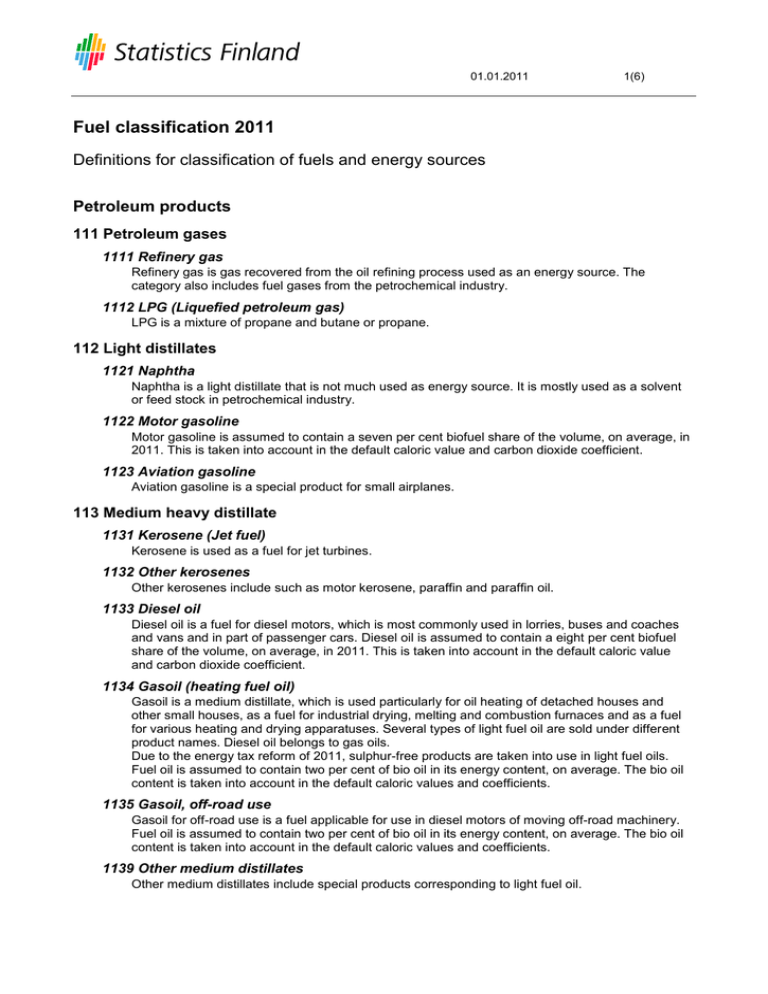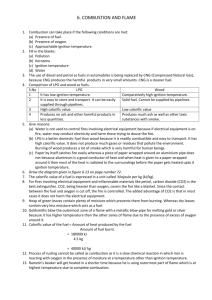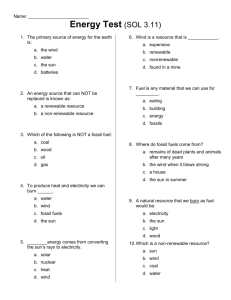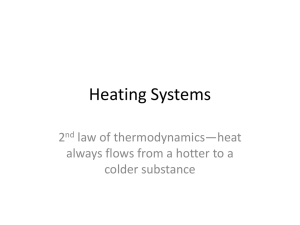Fuel classification 2011 Definitions for classification of fuels and energy sources
advertisement

01.01.2011 1(6) Fuel classification 2011 Definitions for classification of fuels and energy sources Petroleum products 111 Petroleum gases 1111 Refinery gas Refinery gas is gas recovered from the oil refining process used as an energy source. The category also includes fuel gases from the petrochemical industry. 1112 LPG (Liquefied petroleum gas) LPG is a mixture of propane and butane or propane. 112 Light distillates 1121 Naphtha Naphtha is a light distillate that is not much used as energy source. It is mostly used as a solvent or feed stock in petrochemical industry. 1122 Motor gasoline Motor gasoline is assumed to contain a seven per cent biofuel share of the volume, on average, in 2011. This is taken into account in the default caloric value and carbon dioxide coefficient. 1123 Aviation gasoline Aviation gasoline is a special product for small airplanes. 113 Medium heavy distillate 1131 Kerosene (Jet fuel) Kerosene is used as a fuel for jet turbines. 1132 Other kerosenes Other kerosenes include such as motor kerosene, paraffin and paraffin oil. 1133 Diesel oil Diesel oil is a fuel for diesel motors, which is most commonly used in lorries, buses and coaches and vans and in part of passenger cars. Diesel oil is assumed to contain a eight per cent biofuel share of the volume, on average, in 2011. This is taken into account in the default caloric value and carbon dioxide coefficient. 1134 Gasoil (heating fuel oil) Gasoil is a medium distillate, which is used particularly for oil heating of detached houses and other small houses, as a fuel for industrial drying, melting and combustion furnaces and as a fuel for various heating and drying apparatuses. Several types of light fuel oil are sold under different product names. Diesel oil belongs to gas oils. Due to the energy tax reform of 2011, sulphur-free products are taken into use in light fuel oils. Fuel oil is assumed to contain two per cent of bio oil in its energy content, on average. The bio oil content is taken into account in the default caloric values and coefficients. 1135 Gasoil, off-road use Gasoil for off-road use is a fuel applicable for use in diesel motors of moving off-road machinery. Fuel oil is assumed to contain two per cent of bio oil in its energy content, on average. The bio oil content is taken into account in the default caloric values and coefficients. 1139 Other medium distillates Other medium distillates include special products corresponding to light fuel oil. 2(6) 114 Heavy distillates Heavy distillates are produced from an undistilled cut of crude oil, which is used as a fuel for large oil heating plants and stations, industrial melting and combustion furnaces, and ships and diesel plants. 1141 Heavy fuel oil, low sulphur (< 1%) 1142 Heavy fuel oil, high sulphur( > 1 %) 1143 Other heavy distillates Other heavy distillates include special products such as extra heavy bottom oil and other bottom oils. 115 Petroleum coke Includes coke produced from oil by distillation and catalytic FCC and TCC coke by cracking. 116 Recycled and waste oils The oils that are recovered from use after possible refining and are utilised as energy sources. 119 Other petroleum products This category includes oil products not belonging to other categories, such as process gas produced from heavy fuel oil. Please specify which oil products are reported in this group. Coal 121 Hard coal Hard coal refers to a solid organic fossil fuel whose calorific value in an ash-free substance is over 24 MJ per kg. Types of hard coal are mainly classified by the amount of volatile matter and calorific value. 1211 Anthracite Anthracite is the oldest by geological age and the most advanced type of hard coal with a low content of volatile matter. The net calorific value of anthracite is highest, about 33 MJ per kg. 1212 Hard coal, bituminous Includes types of coal whose calorific value is at least 24 MJ per kg, excluding anthracite. 122 Other coal 1221 Semi-bituminous coal, brown coal, lignite Brown coal is the youngest coal by geological age. It is less carbonised than hard coal but it contains more volatile components such as hydrogen and oxygen. The calorific value of brown coal is under 24 MJ per kg. 1222 Coal briquettes Pieces of certain size produced from hard coal by adding binding agents. 1228 Coal tar Tar formed of hard coal in connection with the production of coke. 1229 Other non-specified coal Coal other than belonging to the categories above. Please specify which coal product is used as a fuel. 123 Coke Coke is a fuel produced from hard coal by pyrolysis. The category also includes semi-coke. 124 Coke oven gas Gas obtained as a by-product from the production of coke, containing hydrogen and light hydrocarbon gases. Gas is used as an energy source at coking plants and elsewhere in the iron and steel industry. 3(6) 125 Blast furnace gas Blast furnace gas produced in a blast furnace, which is used after refining as a fuel for heating and energy production. This group also includes CO gas comparable to blast furnace gas. Natural gas 131 Natural gas Natural gas contains primarily methane and some other light hydrocarbons. Natural gas is used as an energy source in manufacturing industry and energy production. Natural gas can also be used as a transport fuel and as a feed stock in the production of hydrogen. Peat Peat is an organic type of soil generated as a result of slow decay of marsh plants, decomposed incompletely and stored in the habitat under extremely wet conditions. Peat is used as a fuel after drying. Snag trees among peat are considered as part of peat. If wood or other fuel has been added to peat, each fuel is reported separately. 211 Milled peat Milled peat is a fine powder milled from the peatland surface. Typical properties as fired: moisture content 40–50 %, net calorific value 9–11 GJ/t. 212 Sod peat Sod peat is peat compressed into pieces and separated from the peatland surface. Typical properties as fired: moisture content 35–40 %, net calorific value 11–13 GJ/t. 213 Peat pellets and briquettes Peat pellets and briquettes are a fuel produced from dried powdered peat by compression. Typical properties as fired: moisture content 5–10 %, net calorific value 17–21 GJ/t. Biomass 311 Forest fuelwood Includes wood harvested for energy use collected from forests or energy wood plantations, etc. 3111 Firewood (stems and split firewood) The raw material of chopped firewood is firewood (usually 1 m in length) or culled diameter stem. Chopped firewood is chopped and cut furnace-ready firewood used in households’ wood-heated equipment, such as stoves, fireplaces and central heating systems. Typical properties as fired: moisture content 20–25 %, net calorific value 13–15 GJ/t. 3112 Whole tree chips (from roundwood Chips made from culled stem wood or from the entire superterranean biomass of the tree (stem wood, branches, needles). Typical properties as fired: moisture content 40–55 %, net calorific value 7–11 GJ/t. 3113 Forest residue chips After harvesting of commercial timber, chips or chippings made from branches and tree tops. Also includes chips or chippings produced from twig logs or stumps. Typical properties as fired: moisture content 40–60 %, net calorific value 6–11 GJ/t. 312 Industrial wood residues Wood residue or by-product produced in the wood processing or other industry used as an energy source. 3121 Bark Bark residue derived from commercial timber by different debarking techniques. Typical properties as fired: moisture content 45–65 %, net calorific value 5–11 GJ/t. 4(6) 3122 Sawdust, cutter shavings etc. Residue from sawing and planing or grinding of timber. Also includes grinding powder and other wood dust. Typical properties as fired: - Sawdust: moisture content 45–60 %, net calorific value 6–10 GJ/t - Cutter shavings and grinding powder: moisture content 5–15 %, net calorific value 16–18 GJ/t 3123 Wood residue chips or chippings Chips or chippings from industrial wood residue (wood strips, offcuts, veneers in the board industry, plywood edges, etc.) and unbarked or barked chips or chippings produced as byproducts by the wood industry, which do not contain halogenated organic compounds, heavy metals or plastics. Typical properties as fired: - Wood residue chippings: moisture content 10–60 %, net calorific value 6–17 GJ/t - Plywood residue: moisture content 5–15 %, net calorific value 10–19 GJ/t 3128 Unspecified industrial wood residue Includes industrial wood residue composed of at least two of the above categories (e.g. bark and sawdust), which cannot be separated even by an approximate estimate. 3129 Other industrial wood residue Includes other wood residue classified as biofuels (e.g. from the construction material industry), which do not contain halogenated organic compounds, heavy metals and other such impurities. 313 Black liquor and other concentrated liquors Includes black liquor and sulphite-based chemical liquor. 314 Other by-products from wood processing industry Includes other industrial by-products and waste products derived from wood by the wood industry, such as pine oil, birch oil, turpentine, pitch, tar, potassium soap, fibre-containing sludge (0 fibre), weak and strong odour gases and refuse paper not fit for material recycling created in paper production, or other paper, cardboard, paperboard or viscose waste. 315 Recovered wood Clean wood residue classified as a biofuel or disposed wood or wood product, which does not contain coatings or halogenated organic compounds and heavy metals. For example, wood residue, wood or loading pallets. 316 Wood pellets and briquettes Compressed wood made by compression from sawdust, shavings and grinding dust. Typical properties as fired: moisture content 8–10 %, net calorific value 15–18 GJ/t. 317 Vegetable-based fuels Vegetable-based fuels include field biomass and residues, and waste from other than arboreal plants, as well as vegetable-based by-products from the food industry. These are cereal, reed canary grass, straw, reed grass, turnip rape and linen. 3171 Reed canary grass Reed canary grass is an energy plant used as fuel. It is usually burned as mixed fuel together with peat and wood. The components of the mixture are reported separately in their own respective fuel categories. 3172 Cereal crops and straw parts Cereals or parts of cereal crops such as straw used as fuel. 3179 Other vegetable-based fuels This category includes, among other things, vegetable-based by-products from food production or the food industry. Please report the products that have been used as fuel. 5(6) 318 Animal-based fuels Animal-based fuels include such as meat and bone flour and animal fats. The category also includes dung and litter. Please specify which products have been used as a fuel. Other biofuels and mixed fuels 321 Biogas Biogas is the result of a microbiological process, where organic matter is decomposed due to bacterial activity in an anaerobic state. Biogas and digested biomass are produced from the raw material as a result of the decomposition. 3211 Landfill gas Biogas recovered from landfills. Methane content around 35–60%. 3212 Biogas from wastewater treatment plants Biogas produced in wastewater treatment plants. Methane content around 60–70%. 3213 Industrial biogas Biogas produced in industrial wastewater treatment plants, and from industrial biodegradable waste and by-products (e.g. in the food and forest industries). Methane content around 65–70%. 3219 Other biogases Other biogases include biogas produced on farms and in co-digestion plants. Co-digestion plants differ from other plants.in that they use diversified raw materials, such as waste sludges, and municipal and industrial wastes or by-products. Methane content around 55–65%. 322 Liquid biofuels Liquid fuels produced from biomass or vegetable oil used as such (not mixed into fossil fuels). The category also includes bio-based propane, which is produced as a by-product of oil refining. This does not include biofuel shares mixed into traffic fuels and fuel oils. Pine oil and methanol derived from the wood processing industry is included in category 314 Other by-products from wood processing industry. 323 Mixed fuels (fossil and non-fossil) Mixed fuels refer to fuels containing both fossil and renewable (biodegradable) coal. 3231 Recovered fuels Fuel produced from sorted municipal solid, enterprise or industrial waste, such as REF, RDF, energy waste or dry waste. 3232 Demolition wood Wood waste from the demolition of buildings and structures containing coatings or other impurities, and does not thus belong to category 315 Recovered wood. 3233 Impregnated wood (chemically treated) Impregnated wood products, e.g. railway sleepers. 3238 Municipal waste (unsorted) Unsorted municipal waste that is used as fuel in energy production. 3239 Other mixed fuels Other mixed fuels and gases not belonging to the categories above, such as unspecified industrial waste and de-inking waste. If the fossil part of these fuels is not specified separately, they are counted as totally fossil in the emissions trading system. 324 Gasified waste (Product gas) Fuel gas produced from solid raw materials in a thermal gasification process. The energy of product gas is reported as the energy content of its raw materials, in other words inclusive of losses from the gasification process. In energy statistics product gas is recorded as its raw materials. 6(6) 325 Biosludge Includes sludge from municipal waste water treatment, which is used as fuel after desiccation. Fibrous sludges from the wood processing industry are reported in category 314 Other by-products from wood processing industry. Nuclear energy 411 Nuclear energy Other energy sources 491 Other by-products and wastes used as fuel Solid and liquid waste and by-products not belonging to other categories used as an energy source. 4911 Plastics waste Includes various plastics waste, e.g. mobile phone covers. 4912 Rubber waste Includes various rubber waste, such as car tyres and other waste rubber. 4913 Hazardous waste 4919 Other waste Waste not belonging to any of the above categories. 492 Exothermic heat from industry Industrial reaction heat refers to heat generated as a by-product of an exothermic heat-transferring chemical reaction in an industrial process (such as calcination, catalytic process). The energy content of the formed heat has not previously been included in the usage figures of any other energy sources. Reaction heat is utilised in electricity and/or heat generation and it replaces other primary energy. This category also includes heat recovered from combustion gases not included in the net calorific value of fuels, which lowers the need for other primary energy. 493 Secondary heat from industry Secondary heat/energy recovered from industry, which is used for production of electricity and/or heat (such as heat recovered from a ground wood or refining plant). Secondary heat utilised in industry has to be included as a 'fuel' of electricity and heat production so that the efficiency would not rise above 100 per cent at the plant level. 494 Electricity Electricity used in heat pumps and electric boilers. 495 Steam Steam acquired from outside for energy production. 497 Sulphur Sulphur generated in processes, which is used as fuel in energy production. 498 Hydrogen 499 Other non-specified energy sources Fuels or energy sources not belonging to the categories above. Please specify which products are used as a energy source.







